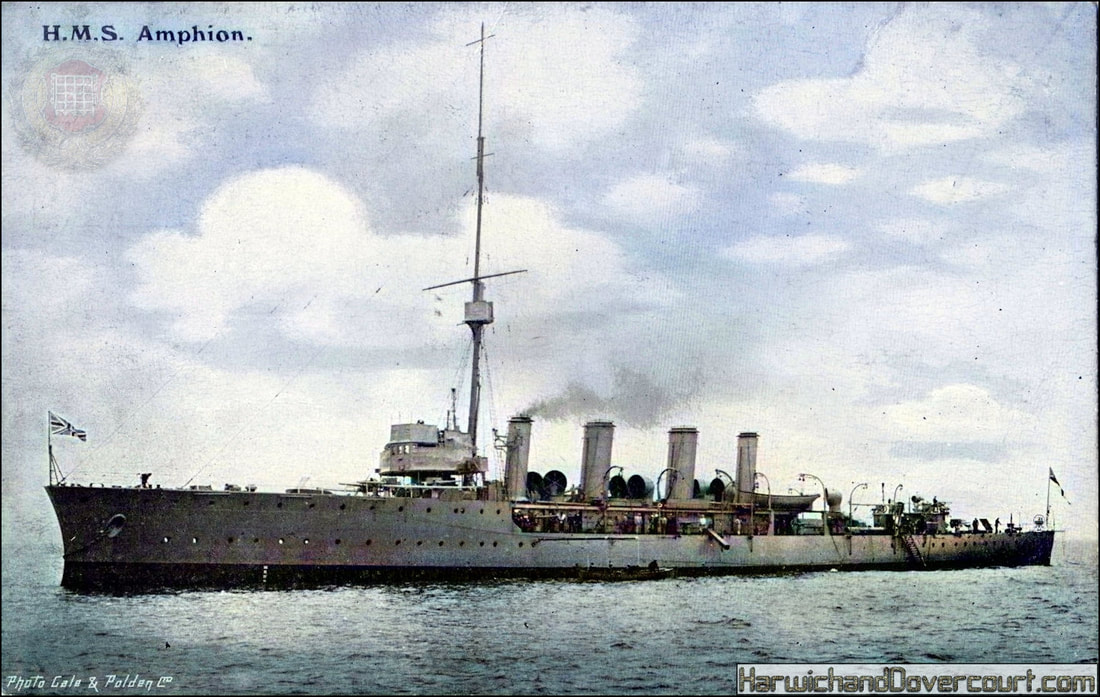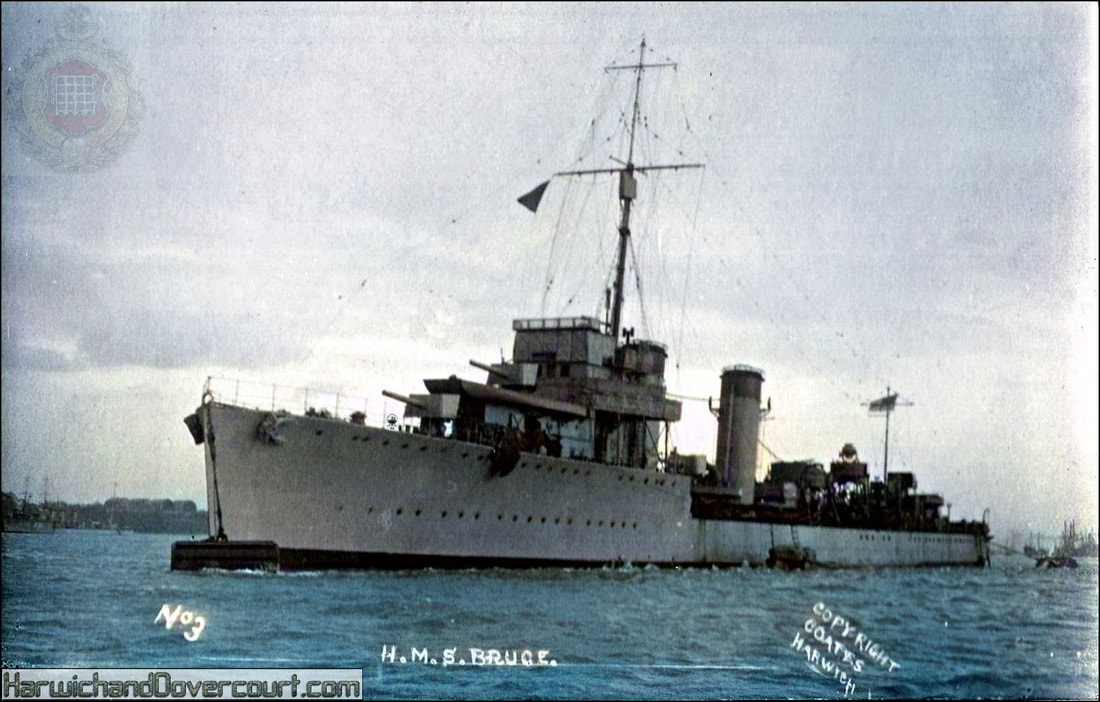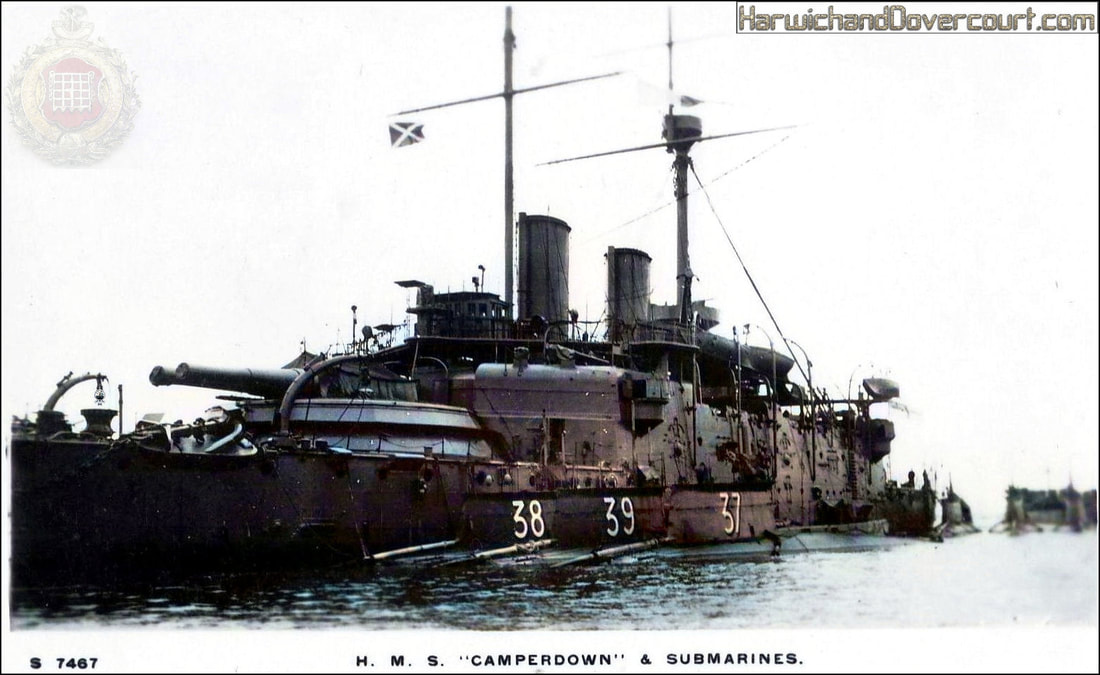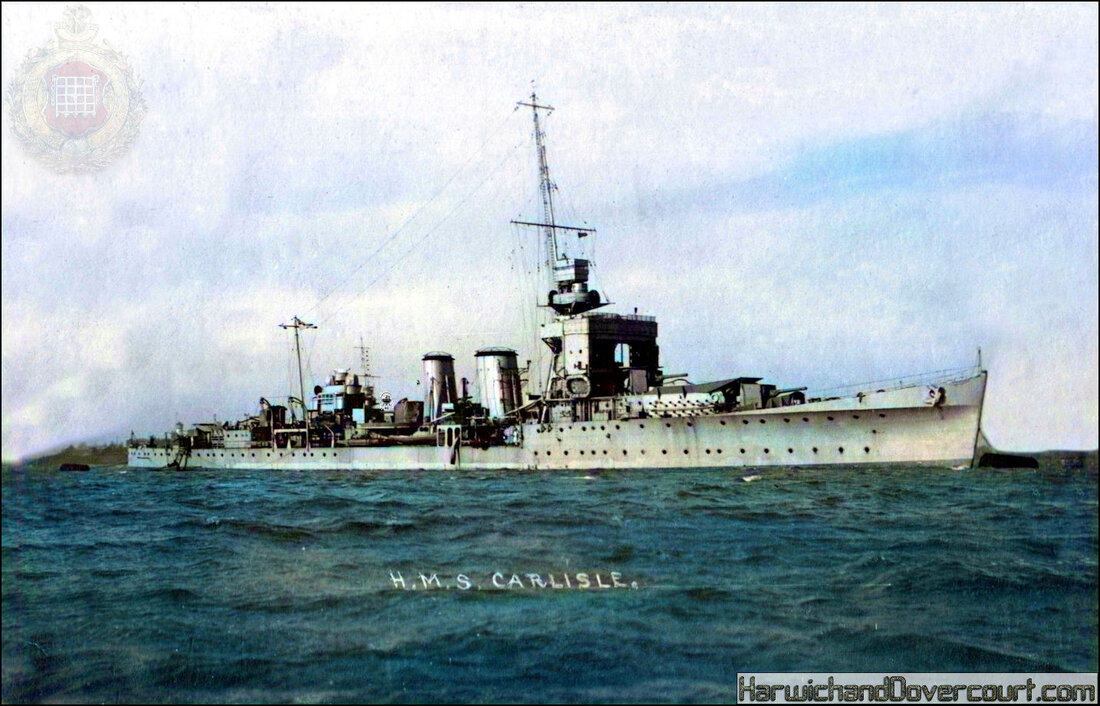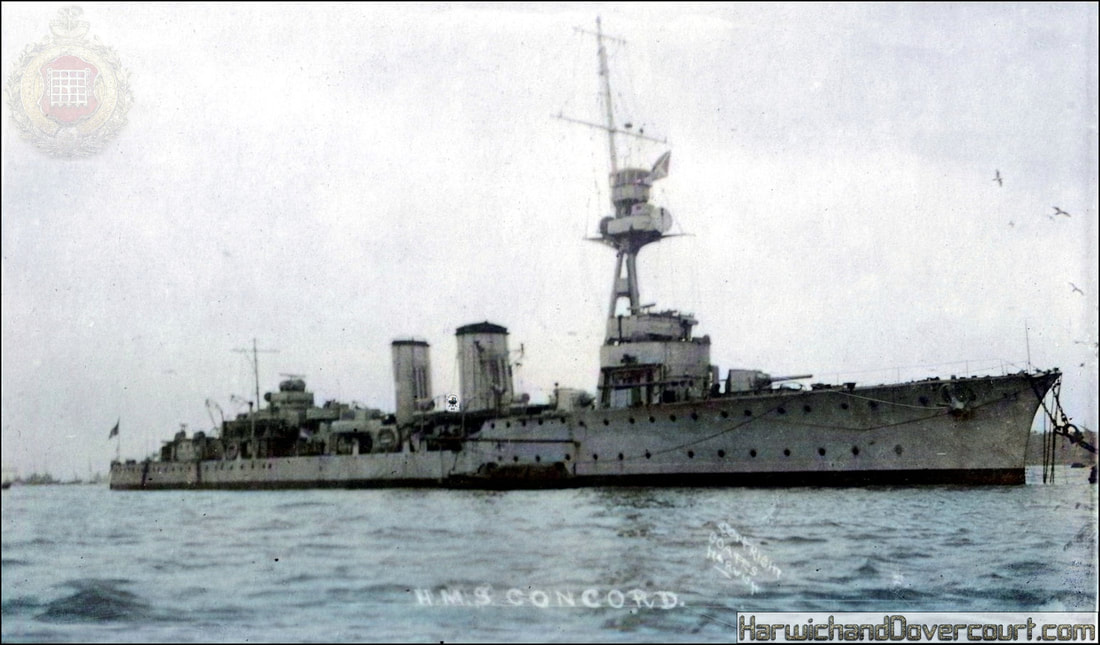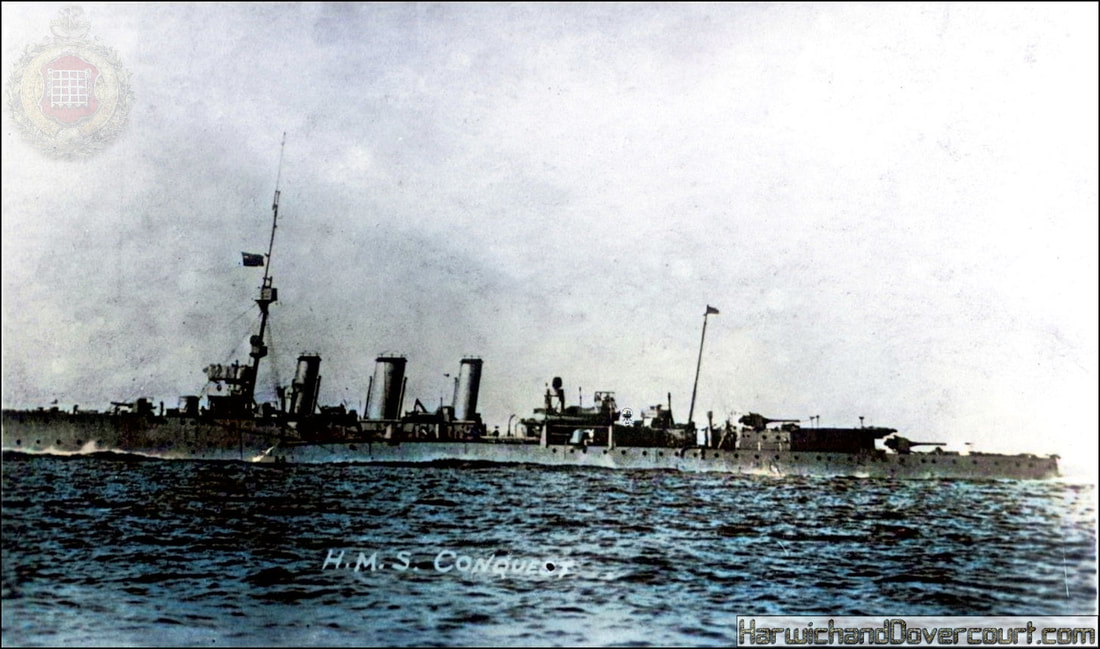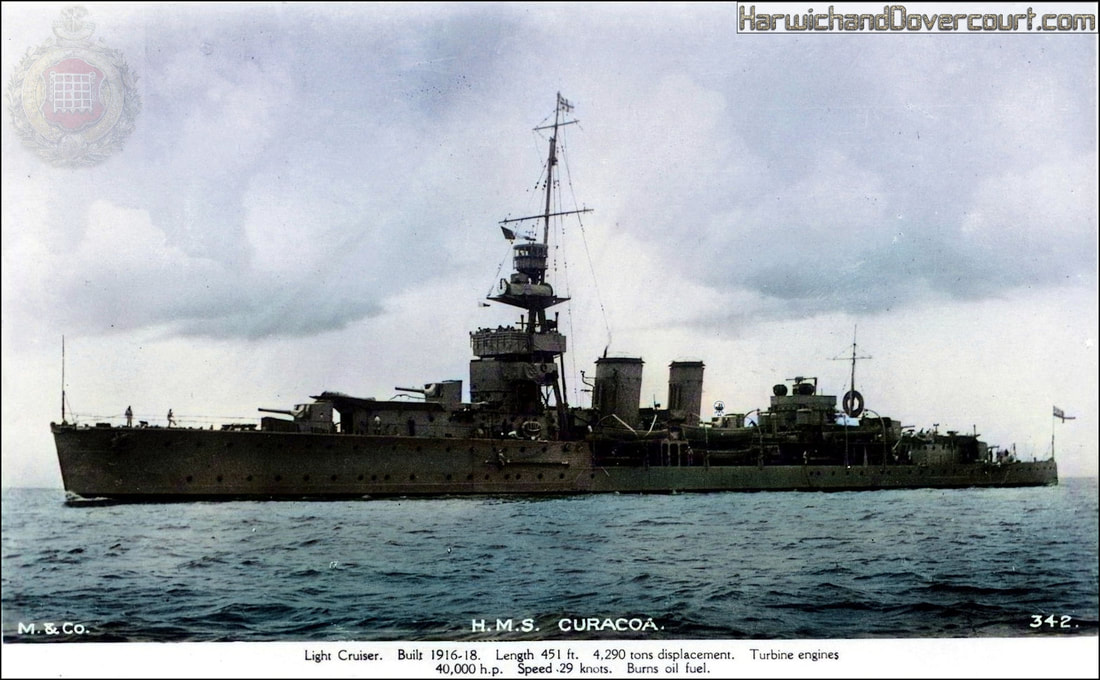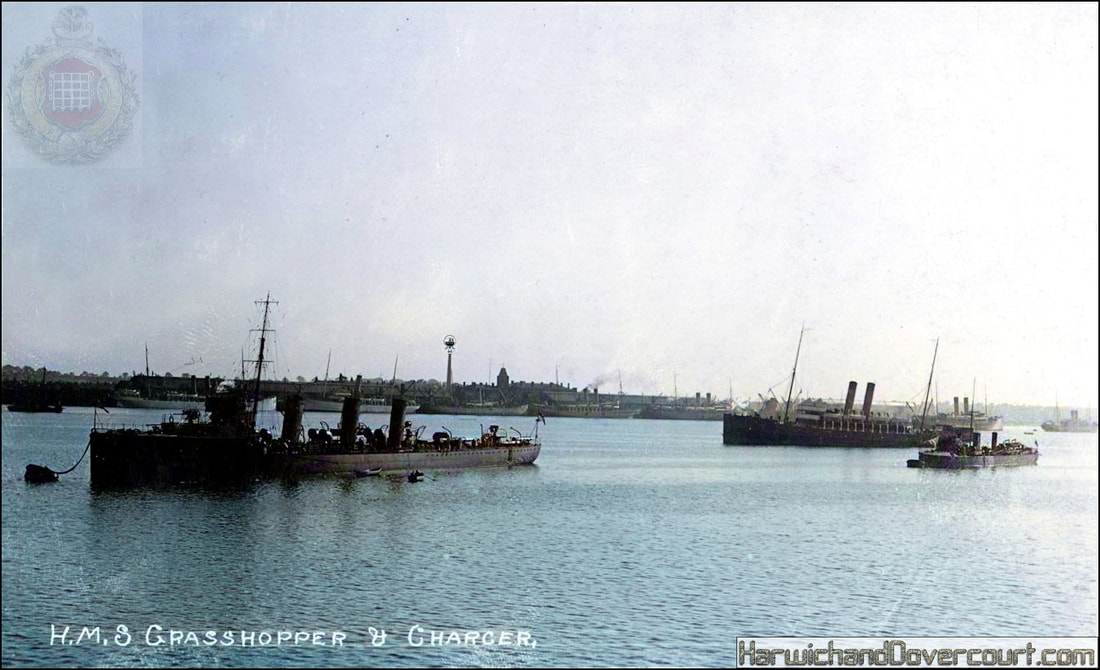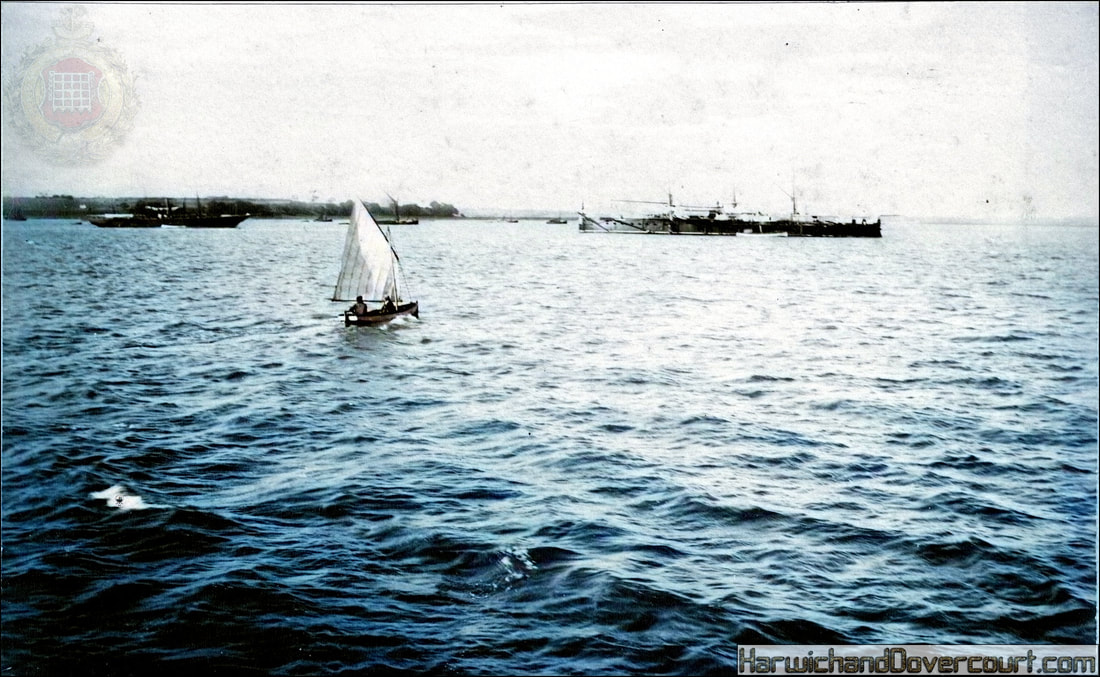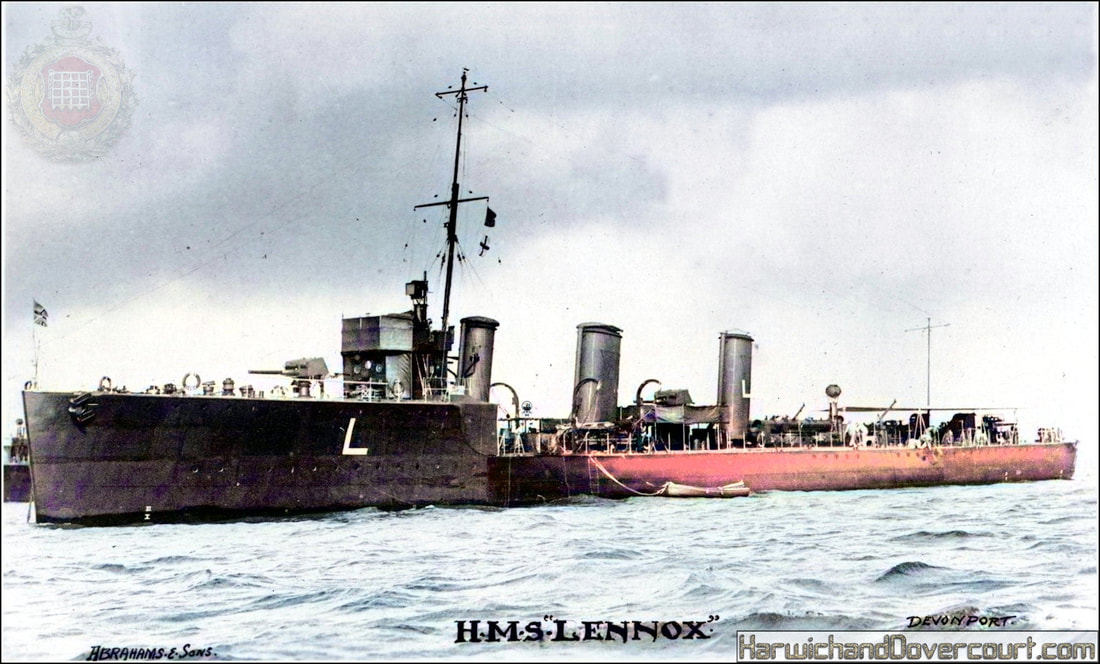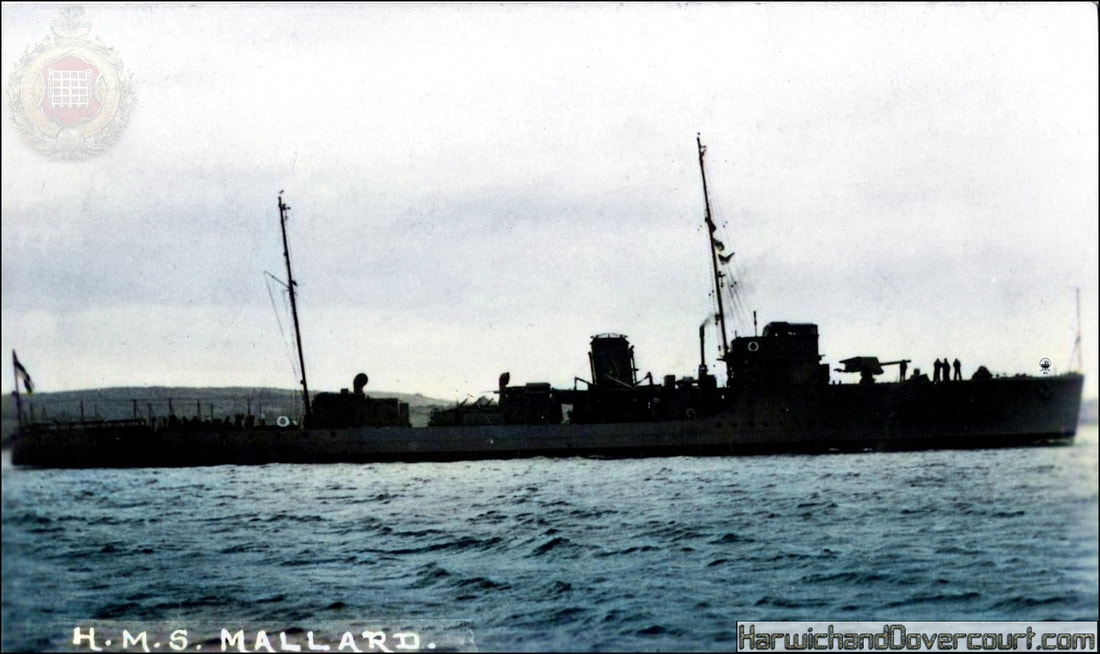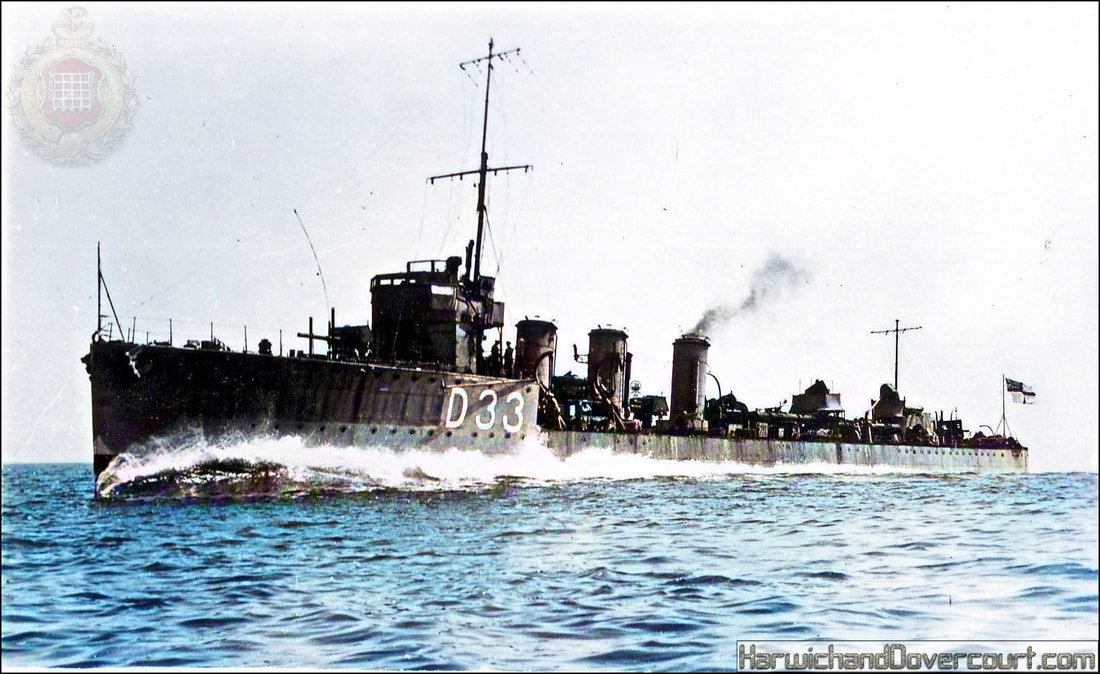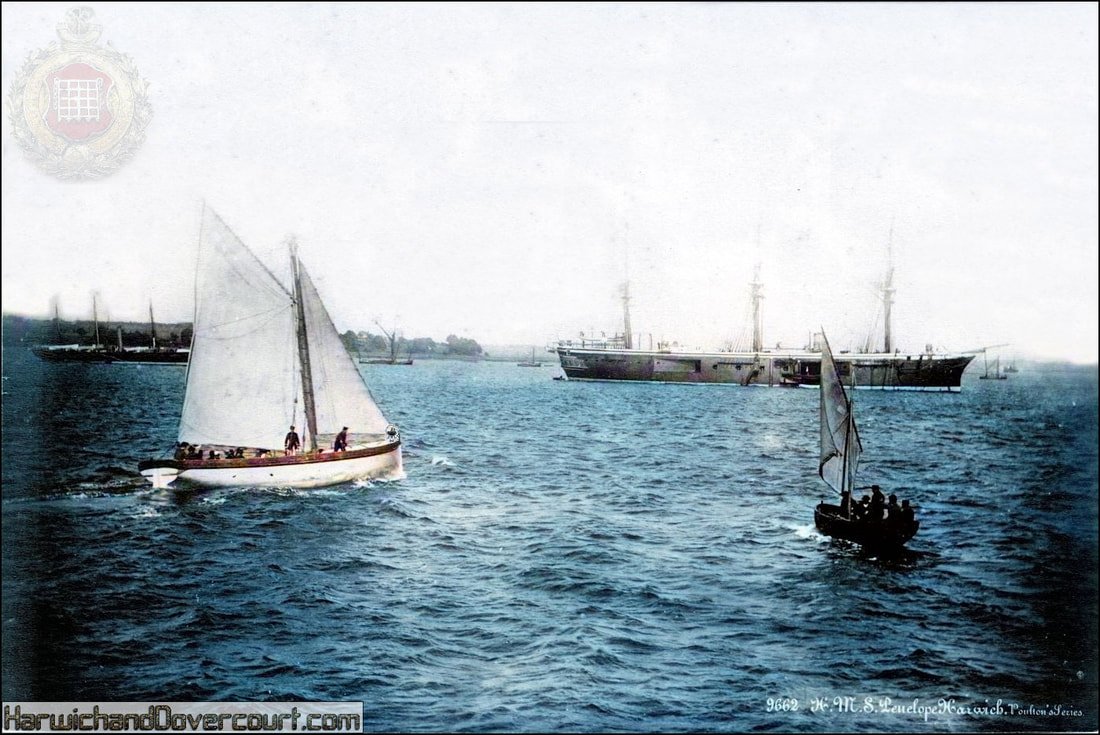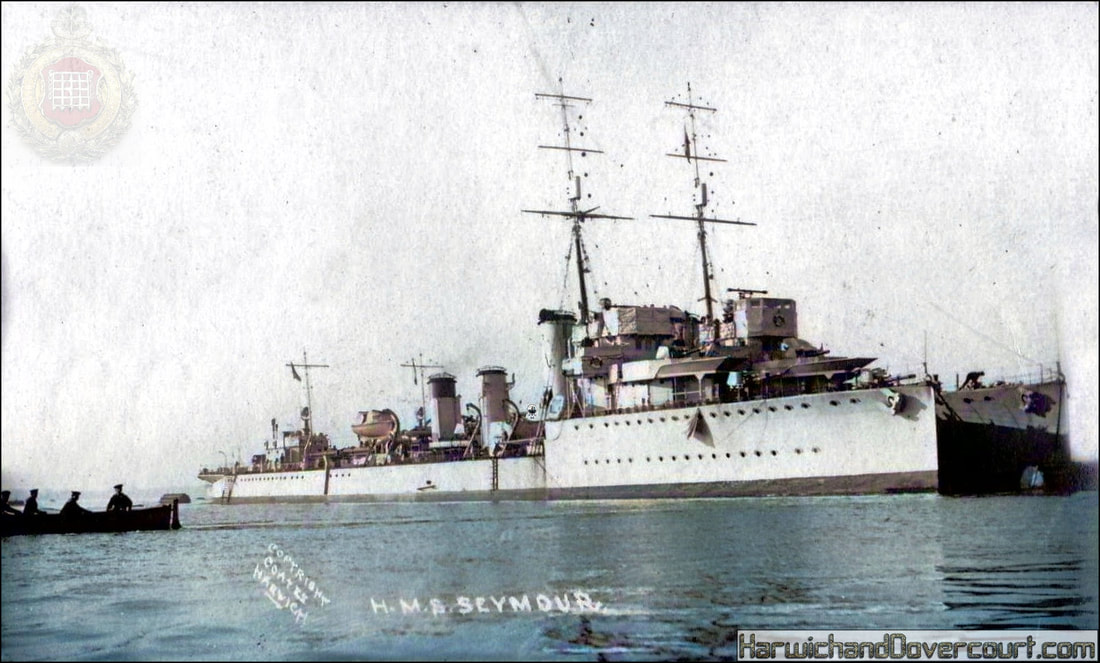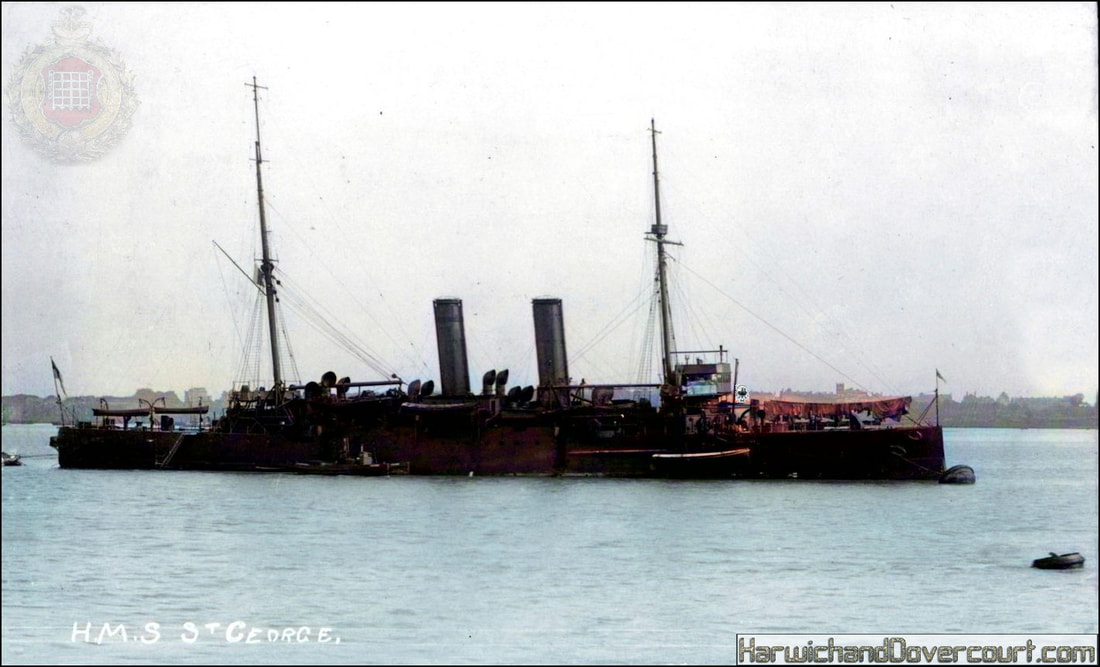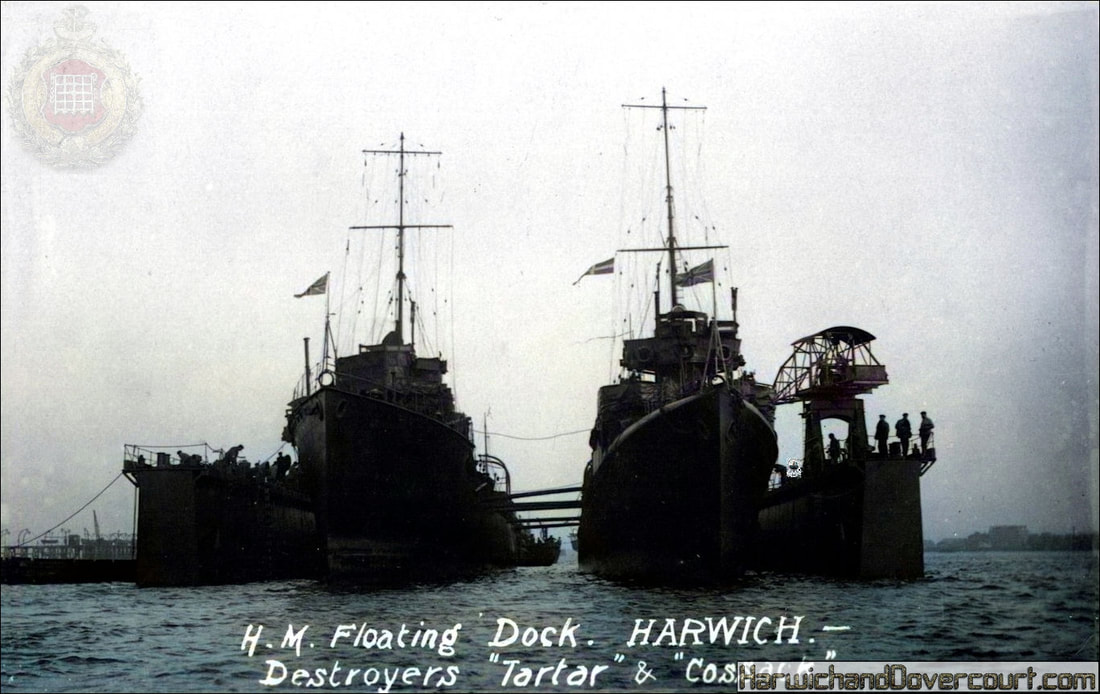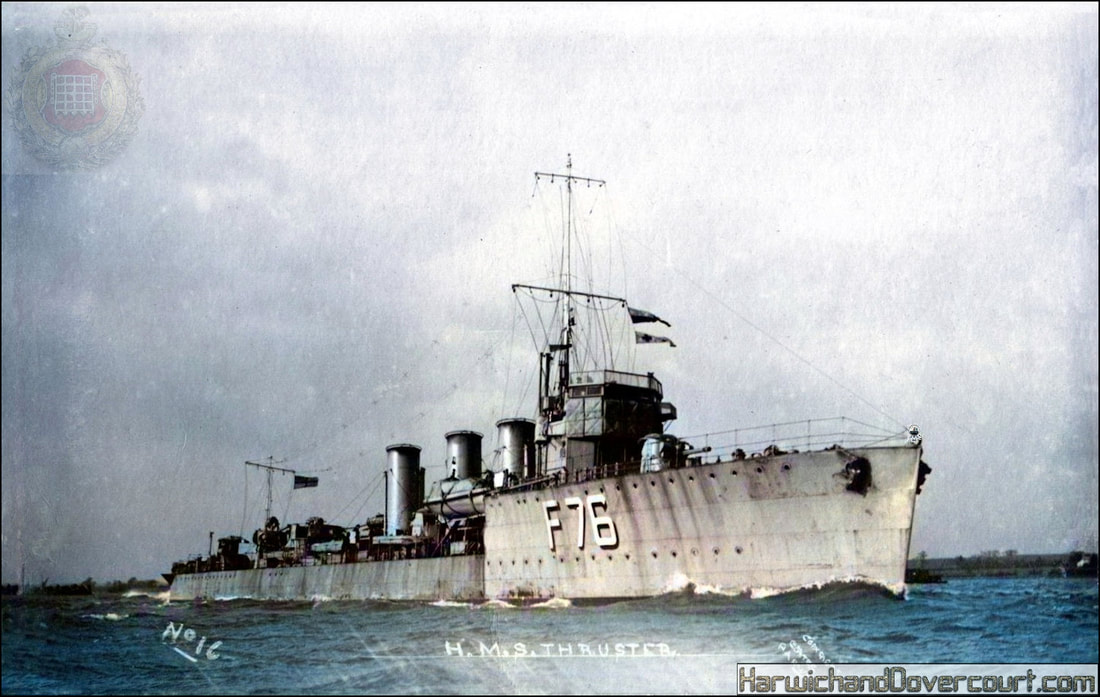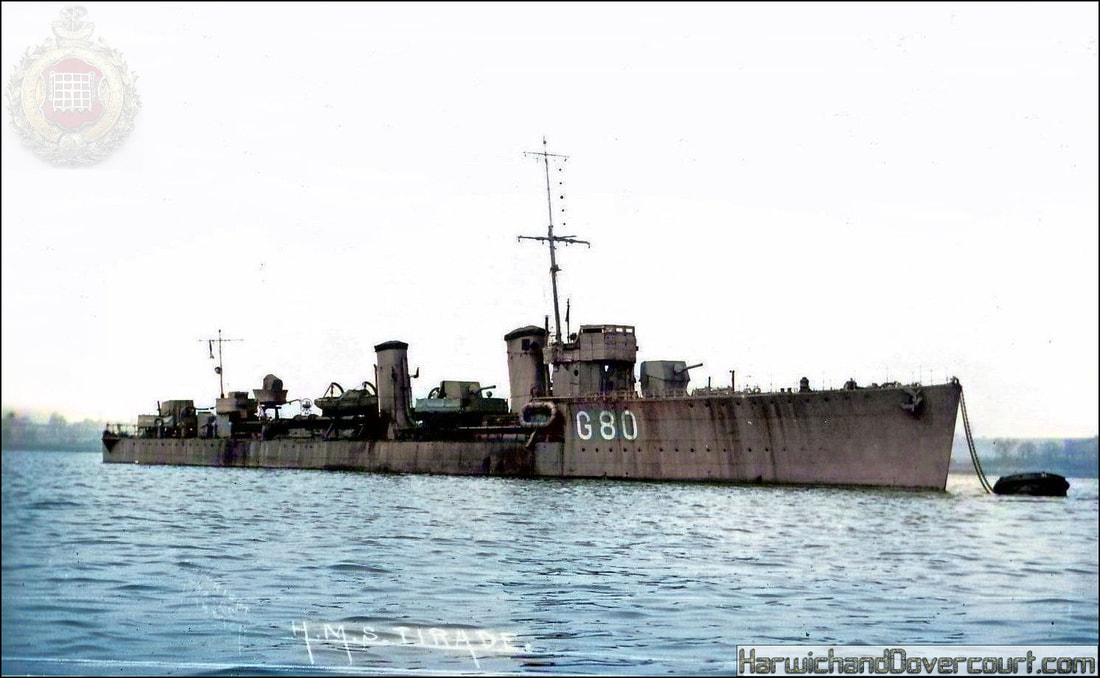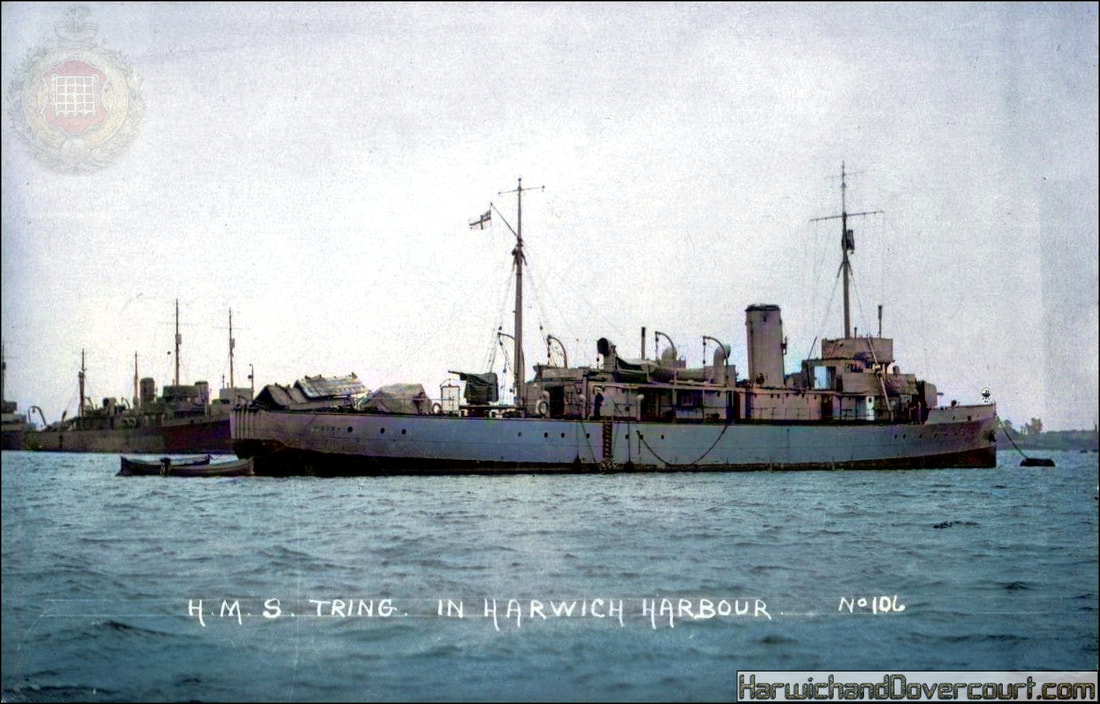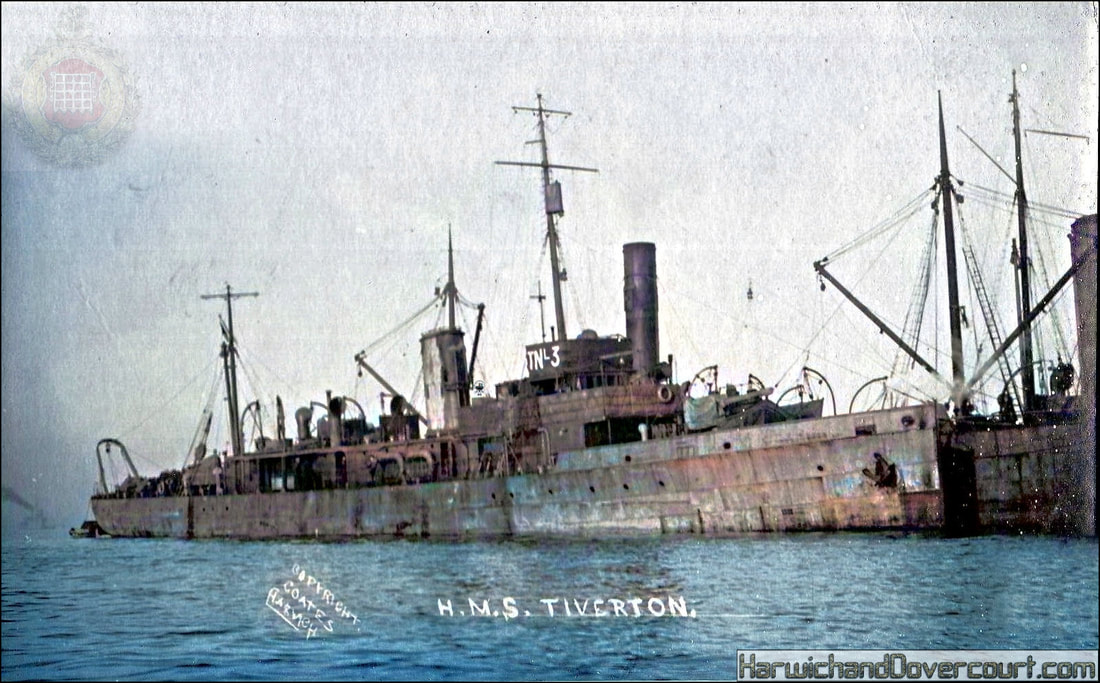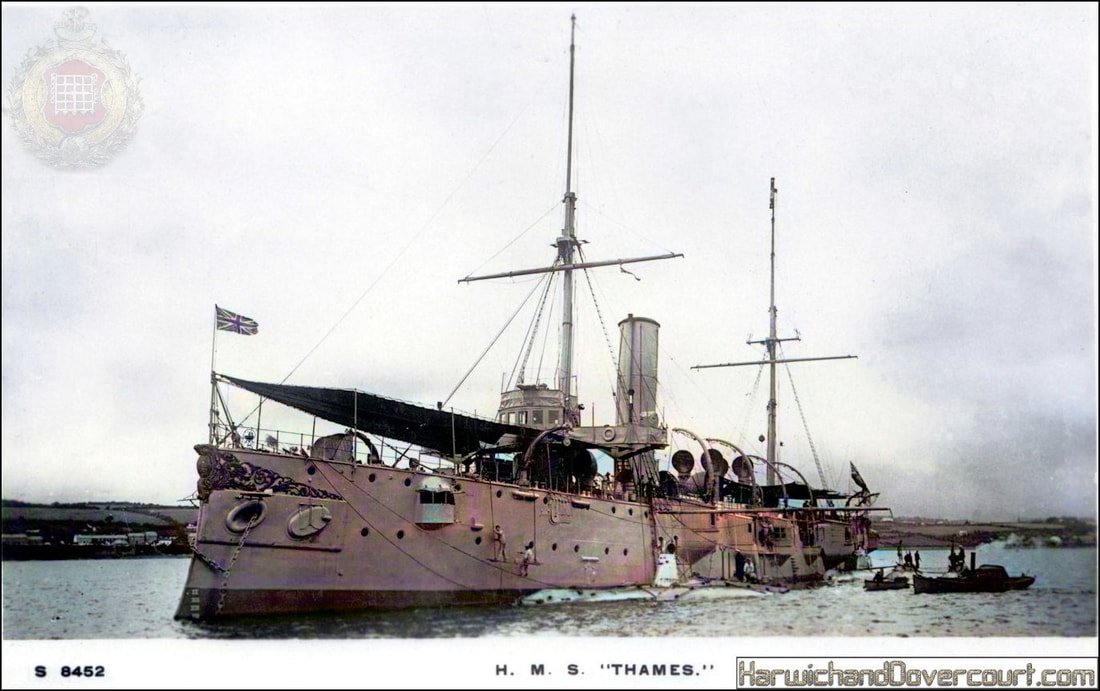~ Royal Navy Shipping Associated with The Harwich Forces ~
~ H.M.S. Amphion (1914) Gale & Polden H&D ~
H.M.S. Amphion
HMS Amphion was an Active-class scout cruiser of the Royal Navy. She was built at Pembroke Dockyard and launched on 4 December 1911. She became the first ship of the Royal Navy to be sunk in the First World War.
On commissioning, Amphion was assigned as leader of the 3rd Destroyer Flotilla with the Harwich Force, defending the eastern approaches to the English Channel. During her early years she was commanded by Frederic Charles Dreyer, but by the outbreak of the First World War she was under the command of Captain Cecil H Fox.
HMS Amphion was an Active-class scout cruiser of the Royal Navy. She was built at Pembroke Dockyard and launched on 4 December 1911. She became the first ship of the Royal Navy to be sunk in the First World War.
On commissioning, Amphion was assigned as leader of the 3rd Destroyer Flotilla with the Harwich Force, defending the eastern approaches to the English Channel. During her early years she was commanded by Frederic Charles Dreyer, but by the outbreak of the First World War she was under the command of Captain Cecil H Fox.
~ H.M.S. Amphion Sunk by a German mine (August 1914) H&D ~
~ H.M.S. Andromache (19--) H&D ~
~ H.M.S. Bruce (1914) Coates H&D ~
H.M.S. Bruce
HMS Bruce was the second of eight Admiralty type flotilla leaders of the Royal Navy. Built by Cammell Laird, Bruce was commissioned on 29 May 1918. During World War I, she served with the 10th Destroyer Flotilla at Harwich. She was sunk as a target ship on 22 November 1939.
HMS Bruce was the second of eight Admiralty type flotilla leaders of the Royal Navy. Built by Cammell Laird, Bruce was commissioned on 29 May 1918. During World War I, she served with the 10th Destroyer Flotilla at Harwich. She was sunk as a target ship on 22 November 1939.
~ H.M.S. Camperdown & Submarines alongside (19--) H&D ~
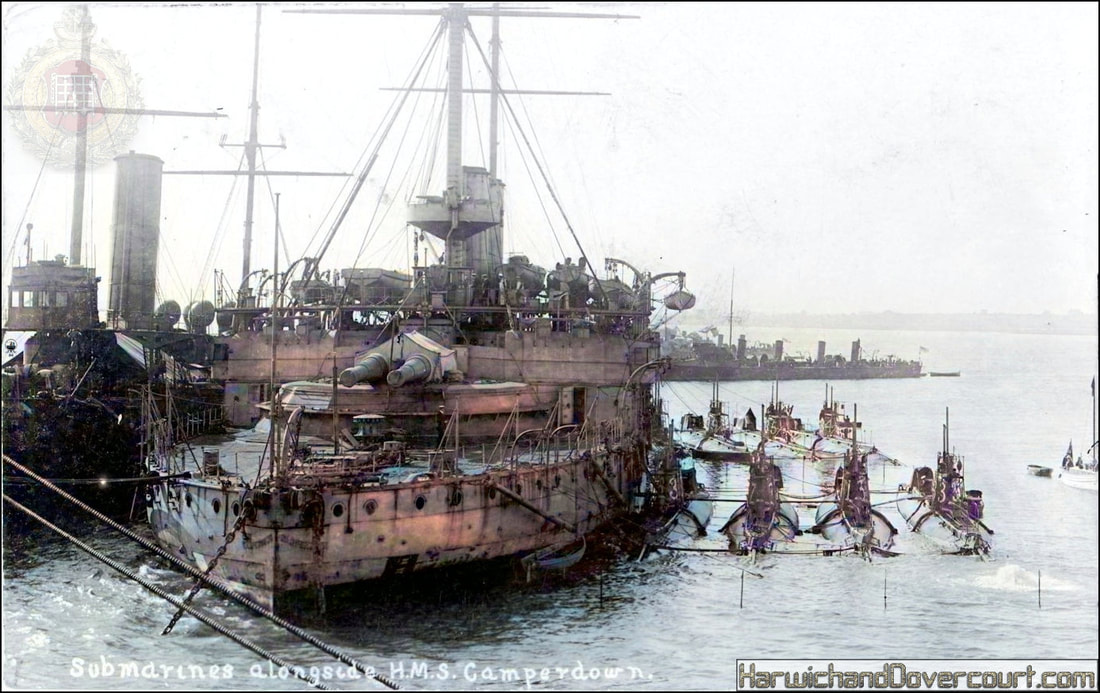
The Battleship HMS Camperdown (built 1885) in Harwich Harbour with Subs.
HMS Camperdown was an Admiral-class battleship of the Royal Navy, named after Adam Duncan, 1st Viscount Duncan of Camperdown. She was commissioned at Portsmouth on 18 July 1889, and initially went into reserve. In December 1889 she was posted to the Mediterranean Fleet as flagship, where she remained until being posted as flagship of the Channel Fleet in May 1890. She was paid off in May 1892 into Fleet reserve, recommissioning in July 1892 into the Mediterranean Fleet. On 22 June 1893, she collided with and sank the battleship Victoria with 358 deaths, including Vice-Admiral Sir George Tryon. In September 1899, she went into Category B reserve, and in May 1900 into Dockyard reserve. In July 1900 she commissioned as a coast guard ship at Lough Swilly until May 1903. During early Summer (April to June) 1902 she visited Portsmouth for repairs to her steam capstan. After paying off in 1903, she was in reserve at Chatham until 1908, and was employed at Harwich as a berthing ship for submarines until she was sold in 1911.
HMS Camperdown was an Admiral-class battleship of the Royal Navy, named after Adam Duncan, 1st Viscount Duncan of Camperdown. She was commissioned at Portsmouth on 18 July 1889, and initially went into reserve. In December 1889 she was posted to the Mediterranean Fleet as flagship, where she remained until being posted as flagship of the Channel Fleet in May 1890. She was paid off in May 1892 into Fleet reserve, recommissioning in July 1892 into the Mediterranean Fleet. On 22 June 1893, she collided with and sank the battleship Victoria with 358 deaths, including Vice-Admiral Sir George Tryon. In September 1899, she went into Category B reserve, and in May 1900 into Dockyard reserve. In July 1900 she commissioned as a coast guard ship at Lough Swilly until May 1903. During early Summer (April to June) 1902 she visited Portsmouth for repairs to her steam capstan. After paying off in 1903, she was in reserve at Chatham until 1908, and was employed at Harwich as a berthing ship for submarines until she was sold in 1911.
~ H.M.S. Camperdown & Submarines S 7467 {19--} H&D ~
~ H.M.S. Camperdown (19--) H&D ~
~ H.M.S. Carlisle (1918) Unknown H&D ~
~ H.M.S. Concord (1918) Coates H&D ~
~ H.M.S. Conquest Part of the Harwich Force (19--) H&D ~
H.M.S. Conquest
This the third ship to carry the name HMS Conquest was a light cruiser.
Built at Chatham Dockyard, laid down 03-Mar-1914, launched 20-Jan-1915 and completed 01-Jun-1915.
On completion joined the 5th Light Cruiser Squadron at Harwich 1915-17. Struck a mine Jul-1918 and repairs took until Apr-1919 after which she went into reserve 1919-22.
To the Atlantic Fleet 1922-26, then the Mediterranean 1927-28. Returned to the UK and into reserve 1928-30 & Sold in1930.
This the third ship to carry the name HMS Conquest was a light cruiser.
Built at Chatham Dockyard, laid down 03-Mar-1914, launched 20-Jan-1915 and completed 01-Jun-1915.
On completion joined the 5th Light Cruiser Squadron at Harwich 1915-17. Struck a mine Jul-1918 and repairs took until Apr-1919 after which she went into reserve 1919-22.
To the Atlantic Fleet 1922-26, then the Mediterranean 1927-28. Returned to the UK and into reserve 1928-30 & Sold in1930.
~ H.M.S. Curacoa Harwich Force (1916) H&D ~
HMS Curacoa
A World War I light cruiser of the "C" class, named after the island in the Caribbean Sea more usually spelled Curaçao. She was part of the Ceres group of the C-class of cruisers. She became one of the major accidental losses of the Royal Navy during World War II. Having 'played' a German battle-cruiser in the 1935 film Brown on Resolution, she served during the early stages of the war with the Home Fleet. She spent four days serving as anti-aircraft protection off Åndalsnes, Norway. During this period, she was seriously damaged by bombs from German aircraft and forced to return to the UK for repairs, that lasted into August. On 2 October 1942 she was engaged in convoy escort duties with the ocean liner RMS Queen Mary. While both ships were zigzagging, the Curacoa crossed the Queen Mary's bow with insufficient clearance. The Queen Mary struck her amidships at a speed of 28 knots, cutting the Curacoa in two. Separated by about 100 yards, she sank instantly with 338 casualties. Due to the risk of U-boats, the Queen Mary could not even slow to assist, and steamed on with a fractured stem.. The following ships in the convoy rescued 99 survivors (including Captain John W. Boutwood, RN) from the water.
A World War I light cruiser of the "C" class, named after the island in the Caribbean Sea more usually spelled Curaçao. She was part of the Ceres group of the C-class of cruisers. She became one of the major accidental losses of the Royal Navy during World War II. Having 'played' a German battle-cruiser in the 1935 film Brown on Resolution, she served during the early stages of the war with the Home Fleet. She spent four days serving as anti-aircraft protection off Åndalsnes, Norway. During this period, she was seriously damaged by bombs from German aircraft and forced to return to the UK for repairs, that lasted into August. On 2 October 1942 she was engaged in convoy escort duties with the ocean liner RMS Queen Mary. While both ships were zigzagging, the Curacoa crossed the Queen Mary's bow with insufficient clearance. The Queen Mary struck her amidships at a speed of 28 knots, cutting the Curacoa in two. Separated by about 100 yards, she sank instantly with 338 casualties. Due to the risk of U-boats, the Queen Mary could not even slow to assist, and steamed on with a fractured stem.. The following ships in the convoy rescued 99 survivors (including Captain John W. Boutwood, RN) from the water.
~ H.M.S. Forth & Submarines (1911) H&D ~
H.M.S. Forth
HMS Forth completed as one of four second class protected cruisers of the Mersey class in 1889, but served in the Great War as a submarine depot ship.
Service
She completed conversion to a sea-going submarine depot ship in August 1904.
In July 1914, she was attached to the Third Submarine Flotilla for the Test Mobilisation.[6] In January, 1915, she transferred to the Tenth Submarine Flotilla. She remained there until August 1916 when she went to help the Eighth Submarine Flotilla, but she remained there only about one month. In September, she was with the Ninth Submarine Flotilla where she would remain through the end of the war.
H.M.S. Forth (1886)
Builder: Pembroke Royal Dockyard
Laid down: 1 Dec, 1884
Launched: 23 Oct, 1886
Commissioned: 1889
Sold:
Captains
Dates of appointment are provided when known.
Commander Sydney S. Hall, May, 1905[7] – 12 November, 1906
Commander Maurice S. FitzMaurice, May, 1906 – 4 October, 1906 (lent)
Commander Wilfred Tomkinson, 12 January, 1912 – August, 1914
Commander Nicholas E. Archdale, 31 October, 1914 – 15 November, 1914 (and for duty with Submarines)
Commander Gilbert H. Kellett, 15 November, 1917
Commander (S) Brownlow V. Layard, February, 1919
HMS Forth completed as one of four second class protected cruisers of the Mersey class in 1889, but served in the Great War as a submarine depot ship.
Service
She completed conversion to a sea-going submarine depot ship in August 1904.
In July 1914, she was attached to the Third Submarine Flotilla for the Test Mobilisation.[6] In January, 1915, she transferred to the Tenth Submarine Flotilla. She remained there until August 1916 when she went to help the Eighth Submarine Flotilla, but she remained there only about one month. In September, she was with the Ninth Submarine Flotilla where she would remain through the end of the war.
H.M.S. Forth (1886)
Builder: Pembroke Royal Dockyard
Laid down: 1 Dec, 1884
Launched: 23 Oct, 1886
Commissioned: 1889
Sold:
Captains
Dates of appointment are provided when known.
Commander Sydney S. Hall, May, 1905[7] – 12 November, 1906
Commander Maurice S. FitzMaurice, May, 1906 – 4 October, 1906 (lent)
Commander Wilfred Tomkinson, 12 January, 1912 – August, 1914
Commander Nicholas E. Archdale, 31 October, 1914 – 15 November, 1914 (and for duty with Submarines)
Commander Gilbert H. Kellett, 15 November, 1917
Commander (S) Brownlow V. Layard, February, 1919
~ H.M.S. Grasshopper & Charger (1912) H&D ~
Harwich Parkeston Quay in the background
~ H.M.S. Hotspur at Harwich Harbour, Essex (1890) H&D ~
~ H.M.S. Lennox (1914) Abraham & Son's H&D ~
~ H.M.S. Mallard (Harwich Force) H&D ~
H.M.S. Mallard
Laid Down : 12th June 1935
Launched : 26th March 1936
Completed : 15th July 1936
Type : Patrol Vessel
Class : Kingfisher
Builder : Stephen
Country : UK
Pennants : L42, K42, M42, P34
Fate : Sold for scrap 21st April 1947.
Laid Down : 12th June 1935
Launched : 26th March 1936
Completed : 15th July 1936
Type : Patrol Vessel
Class : Kingfisher
Builder : Stephen
Country : UK
Pennants : L42, K42, M42, P34
Fate : Sold for scrap 21st April 1947.
~ H.M.S. Mistley (19--) H&D ~
~ H.M.S. Murray (19--) H&D ~
H.M.S. Murray 1914
HMS "Murray" D33 a steam powered torpedo boat destroyer
HMS Murray was an Admiralty M-class destroyer launched in 1914 and sold in 1921.
HMS "Murray" D33 a steam powered torpedo boat destroyer
HMS Murray was an Admiralty M-class destroyer launched in 1914 and sold in 1921.
~ H.M.S. Penelope, Harwich (Aug 31st 1887) Poulton Series H&D ~
~ H.M.S. Renown Bows of ship seen from Bridge (Not Passed By Censor) H&D ~
~ H.M.S. Severn - Greetings From Harwich (1902) H&D ~
#60211 H.M.S. Severn (1903)
H.M.S. Severn was one of four 2nd Class protected Mersey class cruisers completed between 1887 & 1889.
Builder : Chatham Royal Dockyard
Laid down : 1 Jan, 1884
Launched : 29 Sep, 1885
Commissioned : 1888
Sold : 1905
In 1887-88, Severn tested a new submerged broadside tube designed by William H. May. The tube was mounted on the starboard broadside and angled 12 degrees before the beam; its primary distinction over existing designs was that the bar was not extended before firing the torpedo, but emerged into the water with the torpedo as it was fired. This pattern was found to work fairly well after modifications to the original design overcame damage to the propellers of the torpedo as it left and a great number of wild shots. It was retained in hopes that remaining defects could be made good. HMS Severn was commissioned at Portsmouth on 19 February, 1889, by Captain William H. Hall, to relieve H.M.S. Constance on the Pacific Station. Her complement was reported as 243 officers and men, but a further 23 men from the Accountant Branch, Chaplaincy, Domestics and Miscellaneous services brought this to 272 men plus 54 Royal Marines. Whilst serving as Coast Guard ship at Sheerness, Severn was grounded when trying to come into Harwich on 13 December, 1901. It was recorded in the service record of the Captain, Frederick F. Fegen: "My Lords consider that in skirting the shore so close, due care was exercised in the navigation of the ship & further that … the C.O. should not have risked going into Harwich on a falling tide".
H.M.S. Severn was one of four 2nd Class protected Mersey class cruisers completed between 1887 & 1889.
Builder : Chatham Royal Dockyard
Laid down : 1 Jan, 1884
Launched : 29 Sep, 1885
Commissioned : 1888
Sold : 1905
In 1887-88, Severn tested a new submerged broadside tube designed by William H. May. The tube was mounted on the starboard broadside and angled 12 degrees before the beam; its primary distinction over existing designs was that the bar was not extended before firing the torpedo, but emerged into the water with the torpedo as it was fired. This pattern was found to work fairly well after modifications to the original design overcame damage to the propellers of the torpedo as it left and a great number of wild shots. It was retained in hopes that remaining defects could be made good. HMS Severn was commissioned at Portsmouth on 19 February, 1889, by Captain William H. Hall, to relieve H.M.S. Constance on the Pacific Station. Her complement was reported as 243 officers and men, but a further 23 men from the Accountant Branch, Chaplaincy, Domestics and Miscellaneous services brought this to 272 men plus 54 Royal Marines. Whilst serving as Coast Guard ship at Sheerness, Severn was grounded when trying to come into Harwich on 13 December, 1901. It was recorded in the service record of the Captain, Frederick F. Fegen: "My Lords consider that in skirting the shore so close, due care was exercised in the navigation of the ship & further that … the C.O. should not have risked going into Harwich on a falling tide".
~ H.M.S. Seymour (19--) Coates H&D ~
H.M.S. Seymour
H.M.S. Seymour was one of six flotilla leaders of the Parker class.
HMS Seymour, built by Cammell Laird, laid down 23 November 1915, launched 31 August 1916 and completed 30 November 1916. Converted to mine-layer after completion.
She reduced to Reserve at Portsmouth on 17 October, 1919
Converted to a mine layer after completion.
Sold for scrapping in January 1930.
H.M.S. Seymour was one of six flotilla leaders of the Parker class.
HMS Seymour, built by Cammell Laird, laid down 23 November 1915, launched 31 August 1916 and completed 30 November 1916. Converted to mine-layer after completion.
She reduced to Reserve at Portsmouth on 17 October, 1919
Converted to a mine layer after completion.
Sold for scrapping in January 1930.
~ H.M.S. St George at Harwich (19--) H&D ~
H.M.S. St George
HMS St George was a first class cruiser of the Edgar class. She was launched on 23 June 1892.
St George took part in the 40 minute long Anglo-Zanzibar War in 1896. The obsolete armed yacht HHS Glasgow of Zanzibar fired upon a British flotilla led by St George, also comprising Philomel, Racoon, Sparrow and Thrush. The response sank Glasgow with a hole below the waterline. With a Union Jack flying over the sinking yacht in surrender, the flotilla launched lifeboats to rescue the crew of Glasgow which would lie at the bottom of Zanzibar Town Harbour until 1912.
In 1901, she was one of two escort ships for the royal yacht Ophir, which carried the Duke and Duchess of Cornwall and York (later King George V and Queen Mary) during their tour of the British Empire.
Following the end of this tour, the captain of Ophir, Commodore Alfred Winsloe, reverted to his position as Commodore commanding the Cruiser squadron, and was in late 1901 posted to St George, which thus became the lead ship of the squadron and carried his broad pennant. In May 1902 she was taken into Portsmouth for a refit, and later that year she served in the 1902 Coronation review.
She was the flagship of the Cape & West Africa Station (Rear-Admiral Harry Rawson) based at Simon's Town, and served in the First World War.
She was designated as a depot ship in 1909, and sold for breaking up at Plymouth on July 1, 1920.
HMS St George was a first class cruiser of the Edgar class. She was launched on 23 June 1892.
St George took part in the 40 minute long Anglo-Zanzibar War in 1896. The obsolete armed yacht HHS Glasgow of Zanzibar fired upon a British flotilla led by St George, also comprising Philomel, Racoon, Sparrow and Thrush. The response sank Glasgow with a hole below the waterline. With a Union Jack flying over the sinking yacht in surrender, the flotilla launched lifeboats to rescue the crew of Glasgow which would lie at the bottom of Zanzibar Town Harbour until 1912.
In 1901, she was one of two escort ships for the royal yacht Ophir, which carried the Duke and Duchess of Cornwall and York (later King George V and Queen Mary) during their tour of the British Empire.
Following the end of this tour, the captain of Ophir, Commodore Alfred Winsloe, reverted to his position as Commodore commanding the Cruiser squadron, and was in late 1901 posted to St George, which thus became the lead ship of the squadron and carried his broad pennant. In May 1902 she was taken into Portsmouth for a refit, and later that year she served in the 1902 Coronation review.
She was the flagship of the Cape & West Africa Station (Rear-Admiral Harry Rawson) based at Simon's Town, and served in the First World War.
She was designated as a depot ship in 1909, and sold for breaking up at Plymouth on July 1, 1920.
~ H.M.S. Suffolk (19--) H&D ~
~ H.M.S. Tartar, Harwich (1910) H&D ~
HMS Tartar was a Tribal-class destroyer of the Royal Navy launched in 1907 and sold in 1921. During the First World War, she served in the North Sea and the English Channel with the 6th Destroyer Flotilla.
Construction and design
HMS Tartar was ordered from the Southampton shipbuilder John I. Thornycroft & Company under the 1905–06 shipbuilding programme for the Royal Navy, one of five Tribal-class destroyers ordered under that programme. The Tribals derived from a requirement by the First Sea Lord "Jackie" Fisher, for a steam turbine powered, oil-fueled destroyer capable of at least 33 knots (61 km/h; 38 mph). Armament was specified as three 12-pounder (3 in, 76 mm) 12 cwt guns[a] and two 18-inch (450 mm) torpedo tubes. While the Admiralty laid down the basic requirements, the details of the design of individual ships was left to the builders, although the builder's designs did need to be approved by the Director of Naval Construction before orders were placed. This meant that individual ships of the class differed significantly from each other.
Tartar was 274 feet 3 inches (83.59 m) long overall and 270 feet 0 inches (82.30 m) between perpendiculars, with a beam of 26 feet 0 inches (7.92 m) and a draught of 8 feet 4 inches (2.54 m). Displacement was 870 long tons (880 t) normal and 960 long tons (980 t) deep load. Tartar had a turtleback forecastle, but with a raised bow compared with Mohawk (also fitted with a turtleback forecastle), thus avoiding the seakeeping problems that forced Mohawk to be rebuilt with a raised forecastle. Six Thornycroft boilers (in three boiler rooms) fed steam to turbines driving three propeller shafts. The main high-pressure turbine drove the centre shaft, with the outer shafts being fitted with low-pressure turbines, together with cruise and astern turbines. Four funnels were fitted. The ship's machinery was rated at 14,500 shaft horsepower (10,800 kW). The ship had a complement of 74 officers and ratings.
Tartar was laid down at Thornycroft's Woolston shipyard on 13 November 1905 and launched on 25 June 1907. Tartar made 36.3 knots (67.2 km/h; 41.8 mph) during sea trials, with one run during final trials on 16 December reaching a speed of 37.037 knots (68.593 km/h; 42.621 mph), a speed record. She was completed in April 1908. It had been realised during construction that the armament of the Tribals was too light, so it was decided to strengthen the armament of the first five ships of the class by adding another two 12-pounder guns. The two guns were added to Tartar following acceptance by the Royal Navy.
Service
Tartar formed part of the 1st Destroyer Flotilla of the Home Fleet when it was formed in 1909 and remained part of this formation until 1913, when she joined the 4th Destroyer Flotilla based at Portsmouth. In October that year, the Tribals were officially designated the F class, and as such the letter "F" was painted on the bows of the class. In February 1914, the Tribals (including Tartar), as their range was too short for effective open sea operations, were sent to Dover, forming the 6th Destroyer Flotilla. On 8 September 1915, the destroyer Leven was involved in a collision with a transport in the English Channel, suffering a badly damaged bow. She was towed stern first back to Dover, assisted by Tartar, Viking and the tug Lady Crundall.
On the night of 26/27 October 1916, German torpedo boats of their Flanders Flotilla carried out a large scale raid into the English Channel, hoping to attack the drifters watching the anti-submarine nets of the Dover Barrage, and to sink Allied shipping in the Channel. Six Tribal-class destroyers (Tartar, Mohawk, Viking, Nubian, Amazon and Cossack) were being held at readiness at Dover as a fast response force, at readiness in Dover harbour, and when the German 5th Half Flotilla attacked the drifters and sank the old supporting destroyer HMS Flirt, they were ordered to intervene. The destroyers split up as they left Dover harbour, with Viking leading Mohawk and Tartar from the Western entrance to the port, while the other three destroyers left by the Eastern entrance and failed to join up with Viking's group. Nubian and Amazon separately ran into the German 17th Half Flotilla, on its way home after sinking the merchant ship Queen, with Nubian first being badly damaged by a torpedo and Amazon then heavily hit by German shells. Viking's group then encountered a third German formation, the 18th Half Flotilla. Mohawk, second in line of the three British destroyers, was hit by German shells which caused her steering to jam, and turn out of line. Tartar followed Mohawk's turn, while Viking's attempts to pursue the German torpedo boats were thwarted when her course was blocked by Mohawk. All the German torpedo boats that took part in the nights operations escaped successfully.
Tartar struck a German mine on 17 June 1917, killing 43 of her crew, including her newly appointed captain, G. K. Twiss, but was towed to safety.By November 1917, Tartar had joined the 11th Destroyer Flotilla, based at Blyth, Northumberland. On 18 February 1918, Tartar collided with the merchant ship Ardgantock off West Hartlepool, sinking the merchant ship. Tartar still served with the 11th Submarine Flotilla on 11 November 1918, when the Armistice ended fighting between the Allies and Germany.
Disposal
Tartar was sold for scrap on 9 May 1919 to Thos. W. Ward of Hayle.
Construction and design
HMS Tartar was ordered from the Southampton shipbuilder John I. Thornycroft & Company under the 1905–06 shipbuilding programme for the Royal Navy, one of five Tribal-class destroyers ordered under that programme. The Tribals derived from a requirement by the First Sea Lord "Jackie" Fisher, for a steam turbine powered, oil-fueled destroyer capable of at least 33 knots (61 km/h; 38 mph). Armament was specified as three 12-pounder (3 in, 76 mm) 12 cwt guns[a] and two 18-inch (450 mm) torpedo tubes. While the Admiralty laid down the basic requirements, the details of the design of individual ships was left to the builders, although the builder's designs did need to be approved by the Director of Naval Construction before orders were placed. This meant that individual ships of the class differed significantly from each other.
Tartar was 274 feet 3 inches (83.59 m) long overall and 270 feet 0 inches (82.30 m) between perpendiculars, with a beam of 26 feet 0 inches (7.92 m) and a draught of 8 feet 4 inches (2.54 m). Displacement was 870 long tons (880 t) normal and 960 long tons (980 t) deep load. Tartar had a turtleback forecastle, but with a raised bow compared with Mohawk (also fitted with a turtleback forecastle), thus avoiding the seakeeping problems that forced Mohawk to be rebuilt with a raised forecastle. Six Thornycroft boilers (in three boiler rooms) fed steam to turbines driving three propeller shafts. The main high-pressure turbine drove the centre shaft, with the outer shafts being fitted with low-pressure turbines, together with cruise and astern turbines. Four funnels were fitted. The ship's machinery was rated at 14,500 shaft horsepower (10,800 kW). The ship had a complement of 74 officers and ratings.
Tartar was laid down at Thornycroft's Woolston shipyard on 13 November 1905 and launched on 25 June 1907. Tartar made 36.3 knots (67.2 km/h; 41.8 mph) during sea trials, with one run during final trials on 16 December reaching a speed of 37.037 knots (68.593 km/h; 42.621 mph), a speed record. She was completed in April 1908. It had been realised during construction that the armament of the Tribals was too light, so it was decided to strengthen the armament of the first five ships of the class by adding another two 12-pounder guns. The two guns were added to Tartar following acceptance by the Royal Navy.
Service
Tartar formed part of the 1st Destroyer Flotilla of the Home Fleet when it was formed in 1909 and remained part of this formation until 1913, when she joined the 4th Destroyer Flotilla based at Portsmouth. In October that year, the Tribals were officially designated the F class, and as such the letter "F" was painted on the bows of the class. In February 1914, the Tribals (including Tartar), as their range was too short for effective open sea operations, were sent to Dover, forming the 6th Destroyer Flotilla. On 8 September 1915, the destroyer Leven was involved in a collision with a transport in the English Channel, suffering a badly damaged bow. She was towed stern first back to Dover, assisted by Tartar, Viking and the tug Lady Crundall.
On the night of 26/27 October 1916, German torpedo boats of their Flanders Flotilla carried out a large scale raid into the English Channel, hoping to attack the drifters watching the anti-submarine nets of the Dover Barrage, and to sink Allied shipping in the Channel. Six Tribal-class destroyers (Tartar, Mohawk, Viking, Nubian, Amazon and Cossack) were being held at readiness at Dover as a fast response force, at readiness in Dover harbour, and when the German 5th Half Flotilla attacked the drifters and sank the old supporting destroyer HMS Flirt, they were ordered to intervene. The destroyers split up as they left Dover harbour, with Viking leading Mohawk and Tartar from the Western entrance to the port, while the other three destroyers left by the Eastern entrance and failed to join up with Viking's group. Nubian and Amazon separately ran into the German 17th Half Flotilla, on its way home after sinking the merchant ship Queen, with Nubian first being badly damaged by a torpedo and Amazon then heavily hit by German shells. Viking's group then encountered a third German formation, the 18th Half Flotilla. Mohawk, second in line of the three British destroyers, was hit by German shells which caused her steering to jam, and turn out of line. Tartar followed Mohawk's turn, while Viking's attempts to pursue the German torpedo boats were thwarted when her course was blocked by Mohawk. All the German torpedo boats that took part in the nights operations escaped successfully.
Tartar struck a German mine on 17 June 1917, killing 43 of her crew, including her newly appointed captain, G. K. Twiss, but was towed to safety.By November 1917, Tartar had joined the 11th Destroyer Flotilla, based at Blyth, Northumberland. On 18 February 1918, Tartar collided with the merchant ship Ardgantock off West Hartlepool, sinking the merchant ship. Tartar still served with the 11th Submarine Flotilla on 11 November 1918, when the Armistice ended fighting between the Allies and Germany.
Disposal
Tartar was sold for scrap on 9 May 1919 to Thos. W. Ward of Hayle.
~ H.M. Floating Dock, Harwich - Destoyers HMS Tartar & HMS Cossack. (1911) H&D ~
H.M.S. Tartar was a Tribal class destroyer of the Royal Navy launched in 1907 and sold in 1921.
During the First World War she served in the North Sea and the English Channel with the 6th Destroyer Flotilla.
H.M.S. Cossack was also a Tribal class destroyer of the Royal Navy launched in 1907 and sold in 1919.
During the First World War she served in the North Sea and the English Channel with the 6th Destroyer Flotilla.
H.M.S. Cossack was also a Tribal class destroyer of the Royal Navy launched in 1907 and sold in 1919.
~ H.M.S. Tetrarch No #17 (1918) Coates H&D ~
H.M.S. Tetrach
HMS Tetrarch, after the Greek term meaning "ruler of a quarter":
H.M.S. Tetrarch was one of sixty-two destroyers of the "R" class
Built by Harland and Wolff, Govan; launched 20 April 1917; sold for breaking up 28 July 1934
HMS Tetrarch, after the Greek term meaning "ruler of a quarter":
H.M.S. Tetrarch was one of sixty-two destroyers of the "R" class
Built by Harland and Wolff, Govan; launched 20 April 1917; sold for breaking up 28 July 1934
~ H.M.S. Teviot #129 (1913) H&D ~
HMS Teviot (1913)
Was a Yarrow type River Class Destroyer ordered by the Royal Navy under the 1902 – 1903 Naval Estimates. Named after the River Teviot in southern Scotland near the border with England, she was the first ship to carry this name in the Royal Navy. She served during World War 1, primarily on anti-submarine duty in the Channel, and was sold for breaking up in 1919
Name: HMS Teviot
Ordered: 1902 – 1903 Naval Estimates
Builder: Yarrows, Poplar
Laid down: 18 August 1902
Launched: 7 November 1903
Commissioned: April 1904
Out of service: 1919 laid up in reserve awaiting disposal
Fate: 23 June 1919 sold to Thomas W. Ward of Sheffield for breaking at Morecambe, Lancashire.
General characteristics
Class & type: Yarrow Type River Class destroyer[1][2]
Displacement: 590 t (581 long tons) standard
660 t (650 long tons) full load
231 ft 4 in (70.51 m) o/a
23 ft 6 in (7.16 m) Beam
7 ft 2.5 in (2.197 m) Draught
Propulsion: 4 × Yarrow type water tube boiler
2 × Vertical Triple Expansion (VTE) steam engines driving 2 shafts producing 7,000 shp (5,200 kW) (average)
Speed: 25.5 kn (47.2 km/h)
Range: 130 tons coal
1,620 nmi (3,000 km) at 11 kn (20 km/h)
Complement: 70 officers and men
Armament: 1 × QF 12-pounder 12 cwt Mark I, mounting P Mark I
3 × QF 12-pounder 8 cwt, mounting G Mark I (Added in 1906)
5 × QF 6-pdr naval gun (removed in 1906)
2 × single tubes for 18-inch (450mm) torpedoes
Service record
Part of: East Coast Destroyer Flotilla - 1904
3rd Destroyer Flotilla - April 1909
5th Destroyer Flotilla - 1912
Assigned E Class - Aug 1912 - Oct 1913
9th Destroyer Flotilla - 1914
1st Destryer Flotilla - November 1916
Operations: World War I 1914 - 1918
Was a Yarrow type River Class Destroyer ordered by the Royal Navy under the 1902 – 1903 Naval Estimates. Named after the River Teviot in southern Scotland near the border with England, she was the first ship to carry this name in the Royal Navy. She served during World War 1, primarily on anti-submarine duty in the Channel, and was sold for breaking up in 1919
Name: HMS Teviot
Ordered: 1902 – 1903 Naval Estimates
Builder: Yarrows, Poplar
Laid down: 18 August 1902
Launched: 7 November 1903
Commissioned: April 1904
Out of service: 1919 laid up in reserve awaiting disposal
Fate: 23 June 1919 sold to Thomas W. Ward of Sheffield for breaking at Morecambe, Lancashire.
General characteristics
Class & type: Yarrow Type River Class destroyer[1][2]
Displacement: 590 t (581 long tons) standard
660 t (650 long tons) full load
231 ft 4 in (70.51 m) o/a
23 ft 6 in (7.16 m) Beam
7 ft 2.5 in (2.197 m) Draught
Propulsion: 4 × Yarrow type water tube boiler
2 × Vertical Triple Expansion (VTE) steam engines driving 2 shafts producing 7,000 shp (5,200 kW) (average)
Speed: 25.5 kn (47.2 km/h)
Range: 130 tons coal
1,620 nmi (3,000 km) at 11 kn (20 km/h)
Complement: 70 officers and men
Armament: 1 × QF 12-pounder 12 cwt Mark I, mounting P Mark I
3 × QF 12-pounder 8 cwt, mounting G Mark I (Added in 1906)
5 × QF 6-pdr naval gun (removed in 1906)
2 × single tubes for 18-inch (450mm) torpedoes
Service record
Part of: East Coast Destroyer Flotilla - 1904
3rd Destroyer Flotilla - April 1909
5th Destroyer Flotilla - 1912
Assigned E Class - Aug 1912 - Oct 1913
9th Destroyer Flotilla - 1914
1st Destryer Flotilla - November 1916
Operations: World War I 1914 - 1918
~ H.M.S. Thruster No #16 (1919) Coates H&D ~
~ H.M.S. Tirade (19--) Coates H&D ~
H.M.S. Tirade
H.M.S. Tirade was one of sixty-two destroyers of the "R" class.
Upon joining the fleet on 21 July 1917, she joined the Fifteenth Destroyer Flotilla to help escort convoys out of Lough Swilly, despite a minor fault in a 4-in gun and a steering defect that would not be rectified before September.
In early August, she and Rapid were tasked to search for the culprit in torpedoing and sinking a vessel. They found only flotsam and a swimming horse, whom they destroyed. While returning to their convoy, a gunner aboard Tirade sighted the conning tower of a distant submarine, which dived. Tirade dropped two depth charges to no appreciable immediate effect.
Later in the same month, Tirade was among three destroyers escorting three empty oilers when one was torpedoed at sunrise. A second torpedo attack the next midnight failed to hit Tirade and a remaining oiler.
After taking twelve days to address her steering problem, she proceeded to Scapa Flow to work with the Fifteenth. She lost several torpedoes in practice firings and then commenced escorting excruciatingly slow and disorderly convoys from Norway. On 29 September at 2.15 p.m., Moravia pointed her toward UC 55, visible on the surface and in distress due to a diving mishap. Charging in and firing from a range of 3,400 yards, Tirade's third shell struck near the conning tower of the fleeing sub, and her fifth on the aft casing below the waterline. Tirade approached to ram and drop depth charges on her hapless foe, and Sylvia charged in, firing her forward 12-pdr.. Moravia and Rowena attempted to pile on, but the kill was Tirade's. She recovered two of the nineteen Germans rescued from the water.
Stanistreet was awarded a bounty of 145 pounds in February, 1920.
On 21 October, 1917, Tirade accidentally rammed Marmion while they were shepherding another convoy. Tirade suffered little damage, but her victim foundered before she could be towed to safety.
Reduced to C. & M. Party at the Nore on 28 November, 1919.
H.M.S. Tirade was one of sixty-two destroyers of the "R" class.
Upon joining the fleet on 21 July 1917, she joined the Fifteenth Destroyer Flotilla to help escort convoys out of Lough Swilly, despite a minor fault in a 4-in gun and a steering defect that would not be rectified before September.
In early August, she and Rapid were tasked to search for the culprit in torpedoing and sinking a vessel. They found only flotsam and a swimming horse, whom they destroyed. While returning to their convoy, a gunner aboard Tirade sighted the conning tower of a distant submarine, which dived. Tirade dropped two depth charges to no appreciable immediate effect.
Later in the same month, Tirade was among three destroyers escorting three empty oilers when one was torpedoed at sunrise. A second torpedo attack the next midnight failed to hit Tirade and a remaining oiler.
After taking twelve days to address her steering problem, she proceeded to Scapa Flow to work with the Fifteenth. She lost several torpedoes in practice firings and then commenced escorting excruciatingly slow and disorderly convoys from Norway. On 29 September at 2.15 p.m., Moravia pointed her toward UC 55, visible on the surface and in distress due to a diving mishap. Charging in and firing from a range of 3,400 yards, Tirade's third shell struck near the conning tower of the fleeing sub, and her fifth on the aft casing below the waterline. Tirade approached to ram and drop depth charges on her hapless foe, and Sylvia charged in, firing her forward 12-pdr.. Moravia and Rowena attempted to pile on, but the kill was Tirade's. She recovered two of the nineteen Germans rescued from the water.
Stanistreet was awarded a bounty of 145 pounds in February, 1920.
On 21 October, 1917, Tirade accidentally rammed Marmion while they were shepherding another convoy. Tirade suffered little damage, but her victim foundered before she could be towed to safety.
Reduced to C. & M. Party at the Nore on 28 November, 1919.
~ H.M.S. Tring in Harwich Harbour #106 (19--) H&D ~
H.M.S. Tring
Built by William Simons & Co Renfrew,
Yard No 613
Previous Names: TEIGNMOUTH
Propulsion: Steam TE
Launched: Friday, 23/08/1918
Built: 1918
Ship Type: Minesweeper
Ship's Role: Aberdare class
Tonnage: 800t normal
Length: 231ft
Breadth: 28ft 6in
Draught: 7ft 6in
Owner History:
Royal Navy
Status: Sold for Scrapping - 07/10/1927
Remarks:
Laid down as Teignmouth but the name was in changed in June 1918 before launch. Arrived Charlestown 17/11/1927 for scrapping.
Built by William Simons & Co Renfrew,
Yard No 613
Previous Names: TEIGNMOUTH
Propulsion: Steam TE
Launched: Friday, 23/08/1918
Built: 1918
Ship Type: Minesweeper
Ship's Role: Aberdare class
Tonnage: 800t normal
Length: 231ft
Breadth: 28ft 6in
Draught: 7ft 6in
Owner History:
Royal Navy
Status: Sold for Scrapping - 07/10/1927
Remarks:
Laid down as Teignmouth but the name was in changed in June 1918 before launch. Arrived Charlestown 17/11/1927 for scrapping.
~ H.M.S. Tiverton (19-) Coates H&D ~
H.M.S. Tiverton
HMS Tiverton built by William Simons & Co Renfrew was a Hunt class minesweeper of the Royal Navy from World War I.
Launched 1918
Sold in 1938.
HMS Tiverton built by William Simons & Co Renfrew was a Hunt class minesweeper of the Royal Navy from World War I.
Launched 1918
Sold in 1938.
~ H.M.S.Thames S 8452 (1908) Kingsway H&D ~
A Mersey 2nd Class Cruiser.
These Mersey Class ships established the pattern for future British second class cruisers and followed closely from the Leander class, but incorporated for the first time a full length protective deck. They were the first vessels to abandon any form of sailing rig. HMS Thames and HMS Forth were converted to depot ships in 1903/4, and HMS Thames was sold in 1920 to become the Training Ship General Botha, reverting to HMS Thames in 1942, employed as an accommodation ship.
Displacement : 4050 tons. Length : 315 ft. Beam : 46 ft. Depth : 19 ft 6 ins. I.H.P. : 4500. Speed : 17knts. Armament 2 - 8in BLR, 10 6 in BLR, 3 - 6 pdr QF, 3 - 3pdr QF, 0 MGs, 2 TT sub, 2 TC. Complement : 300.
Service History
Laid down: 14 April 1884
Launched: 3 December 1885
Completed: July 1888
Reclassified: Submarine depot ship, 1903
Fate: Sold, 13 November 1920
HMS Thames was a Mersey-class protected cruiser built for the Royal Navy (RN) in the 1880s. The ship was placed in reserve upon her completion in 1888 and was converted into a submarine depot ship in 1903. When HMS Thames completed conversion to a depot ship in July, 1903. During the Test Mobilisation, HMS Thames supported the Fifth Submarine Flotilla, which was then comprised of six "C" class submarines. It remained with the Flotilla when it was made part of the Nore Local Defence Flotilla at the start of the war. In July, 1917, she moved over to support three "C" boats from the Ninth Submarine Flotilla, operating as part of the Harwich Force. In November, 1917, Thames moved to join the Sixth Submarine Flotilla, operating as part of the Portsmouth Local Defence Flotilla.
In October, 1918, Thames moved to the Clyde to support the new Periscope School at Campbeltown under the command of Henry Dale Gill, who'd commanded her previously. She paid off at the Nore on 23 December, 1919.
She was sold out of the navy in 1920 and was purchased by a South African businessman to serve as a training ship for naval cadets under the name SATS General Botha. The ship arrived in South Africa in 1921 and began training her first class of cadets in Simon's Town the following year. General Botha continued to train cadets for the first several years of World War II, but the RN took over the ship in 1942 for use as an accommodation ship under her original name.
She was scuttled by gunfire in 1947 and is now a diveable wreck.
These Mersey Class ships established the pattern for future British second class cruisers and followed closely from the Leander class, but incorporated for the first time a full length protective deck. They were the first vessels to abandon any form of sailing rig. HMS Thames and HMS Forth were converted to depot ships in 1903/4, and HMS Thames was sold in 1920 to become the Training Ship General Botha, reverting to HMS Thames in 1942, employed as an accommodation ship.
Displacement : 4050 tons. Length : 315 ft. Beam : 46 ft. Depth : 19 ft 6 ins. I.H.P. : 4500. Speed : 17knts. Armament 2 - 8in BLR, 10 6 in BLR, 3 - 6 pdr QF, 3 - 3pdr QF, 0 MGs, 2 TT sub, 2 TC. Complement : 300.
Service History
Laid down: 14 April 1884
Launched: 3 December 1885
Completed: July 1888
Reclassified: Submarine depot ship, 1903
Fate: Sold, 13 November 1920
HMS Thames was a Mersey-class protected cruiser built for the Royal Navy (RN) in the 1880s. The ship was placed in reserve upon her completion in 1888 and was converted into a submarine depot ship in 1903. When HMS Thames completed conversion to a depot ship in July, 1903. During the Test Mobilisation, HMS Thames supported the Fifth Submarine Flotilla, which was then comprised of six "C" class submarines. It remained with the Flotilla when it was made part of the Nore Local Defence Flotilla at the start of the war. In July, 1917, she moved over to support three "C" boats from the Ninth Submarine Flotilla, operating as part of the Harwich Force. In November, 1917, Thames moved to join the Sixth Submarine Flotilla, operating as part of the Portsmouth Local Defence Flotilla.
In October, 1918, Thames moved to the Clyde to support the new Periscope School at Campbeltown under the command of Henry Dale Gill, who'd commanded her previously. She paid off at the Nore on 23 December, 1919.
She was sold out of the navy in 1920 and was purchased by a South African businessman to serve as a training ship for naval cadets under the name SATS General Botha. The ship arrived in South Africa in 1921 and began training her first class of cadets in Simon's Town the following year. General Botha continued to train cadets for the first several years of World War II, but the RN took over the ship in 1942 for use as an accommodation ship under her original name.
She was scuttled by gunfire in 1947 and is now a diveable wreck.
